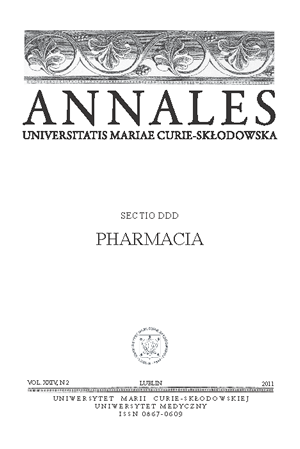Application of the TachoComb to the patients receiving oral anticoagulants after tooth extraction
Keywords:
anticoagulant therapy, tooth extraction, hemostatic surgical dressing, bleedingAbstract
The use of oral anticoagulant medications causes prolonged bleeding after tooth extractions. The problem of local procedures aimed at obtaining normal haemostasis in such patients following tooth extraction still remains an important problem of stomatological practice. The objective of this paper is to evaluate the applicability of the TachoComb hemostatic formula to the local treatment of post-extraction bleeding in patients receiving oral anticoagulants. The TachoComb fibrinous-collagenous haemostatic formula was applied after tooth extraction to 116 patients receiving oral anticoagulants. The control group consisted of 74 patients in whom an anti-thrombotic therapy was discontinued before and during the extractive surgery and whose post-extraction wounds were sutured with compression. Secondary bleeding occurred in 3 patients (2.6%) from the investigated group and in 10 patients (13.5%) from the control group. Local application of the TachoComb formula resulted in obtaining effective haemostasis in 97.4% of the patients. In this group bleeding was reduced in intensity and occurred between the third and fifth day following the extraction. The observations made point out that the TachoComb may be used effectively for the local treatment of bleedings after tooth extraction in patients receiving oral anticoagulants.
References
1. Bailey B.M., Fordyce A.M.: Complication of dental extractions in patients receiving warfarin anticoagulant therapy. A controlled clinical trial. Br. Dent. J., 155, 308, 1983.
2. Blinder D. et al.: Dental estractions in patients maintained on continued oral anticoagulant: comparison of local hemostatic modalitis. Oral. Surg. Oral. Med. Oral. Pathol. Oral. Radiol. Endod., 88, 137, 1999.
3. Blinder D. et al.: Dental extractions in patients maintained on oral anticoagulant therapy: comparison of INR value with occurance of postoperative bleeding. Int . J. Oral. Maxillofac. Surg., 30, 518, 2001.
4. Benoit P.W., Hunt L.M.: Comparison of a microcrystalline collagen preparation and gelatin foam in extraction wounds. J. Oral. Surg., 34, 1079, 1976.
5. Bodner L.J., Weinstein J.M., Kleiner A.: Efficacy of fibrin sealant in patients on various levels of oral anticoagulants undergoing oral surgery. Oral. Surg. Oral. Med. Oral. Pathol. Oral. Radiol. Endod., 86, 421, 1998.
6. Carter G., et al.: (2003). Local hemostasis with autologous fibrin glue following surgical enucleation of a large cystic lesion in a therapeutically anticoagulanted patient. Br .J. Oral. Maxillofac. Surg., 41, 275, 2003.
7. Evans B.E. (1984). Local hemostatic agents (and techniques). Scand. J. Haematol., 40, 417, 1984.
8. Gazda H., Grabowska A.: Miejscowe leczenie krwawień z jamy ustnej dzieci z zaburzeniami krzepnięcia. Wiad. Lek. 46, 111, 1993.
9. Gaspar R., et al.: Use of tranexamic acid mouthwash to prevent postoperative bleeding in oral surgery patients on oral anticoagulant medication. Ouintessence. Int., 28, 375, 1997.
10. Jantet G.H., Rob C.: An experimental and clinical investigation of new haemostatic absorbable gauze. Br. J. Surg., 209, 270, 1960.
11. Lewandowski B., Maresch-Lewandowska M.: (2000). Zastosowanie preparatu Tacho-
Comb w miejscowym leczeniu krwawień poekstrakcyjnych u chorych z zaburzeniami krzepnięcia. Czas. Stomatol., 53, 113, 2000.
12. Lewandowski B.: (2000). Postępowanie chirurgiczno-stomatologiczne u chorych leczonych długotrwale lekami przeciwzakrzepowymi. Stomat. Współ., 7, 20, 2000.
13. Martinowitz M.D., et al.: Dental extraction for patients on oral anticoagulant therapy. Oral. Surg. Oral. Med. Oral. Pathol., 70, 274, 1990.
14. Pierce M., Wiebkin O., Wilson D.F.: (1984). Surgical its fate following implantation. J. Oral. Pathol., 13, 661, 1984.
15. Ramli R., Rahman R.A.: Minor oral surgery in anticoagulanted patients: local measures alone are sufficient for haemostasis. Signapore. Dent. J., 27,13, 2005.
16. Ramstrom G., et al.: Prevebtion of postsurgical bleeding in oral surgery using tranexamic acid without dose modification of oral anticoagulants. J. Oral. Maxillofac. Surg., 51, 1211, 1993.
17. Rooney T.P.: General dentistry during continuous anticoagulation therapy. Oral. Surg. Oral. Med. Oral. Pathol., 56, 252, 1983.
18. Steinberg M.J., Moores J.F.: Use of INR to assess degree of anticoagulation on patients who have dental procedures. Oral. Surg. Oral. Med. Oral. Pathol., 80, 175, 1995.
19. Webster K., Wilde J.: Management of anticoagulation in patients with prosthetic heart valves undergoing oral and maxillofacial operations. Br. J. Oral. Maxillofac. Surg., 38, 124, 2000.
20. Zanon E., et al.: Safety of dental extraction among consecutive patients on oral anticoagulant treatment managed using a specific dental management protocol. Blood. Coagul. Fibrinolysis., 14, 27, 2003.
Downloads
Published
Issue
Section
License
Copyright (c) 2011 Authors

This work is licensed under a Creative Commons Attribution-NonCommercial-NoDerivatives 3.0 Unported License.


